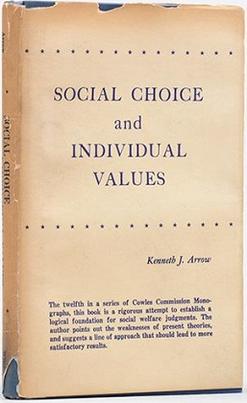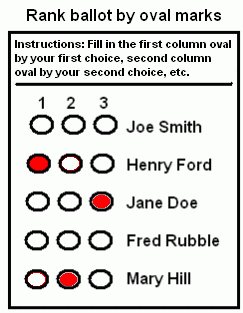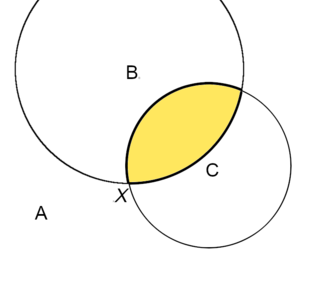
Approval voting is an electoral system in which voters can select any number of candidates instead of selecting only one.
Score voting, sometimes called range voting, is an electoral system for single-seat elections. Voters give each candidate a numerical score, and the candidate with the highest average score is elected. Score voting includes the well-known approval voting, but also lets voters give partial (in-between) approval ratings to candidates.
In social choice theory, a Condorcet paradox is a situation where majority rule behaves in a way that is self-contradictory. In such a situation, every possible choice is rejected by the electorate in favor of another, because there is always some other outcome that a majority of voters consider to be better.
In social choice theory and politics, the spoiler effect refers to a situation where the entry of a losing candidate affects the results of an election. A voting system that is not affected by spoilers satisfies independence of irrelevant alternatives or independence of spoilers.

A Condorcet method is an election method that elects the candidate who wins a majority of the vote in every head-to-head election against each of the other candidates, whenever there is such a candidate. A candidate with this property, the pairwise champion or beats-all winner, is formally called the Condorcet winner. The head-to-head elections need not be done separately; a voter's choice within any given pair can be determined from the ranking.
Independence of irrelevant alternatives (IIA), also known as binary independence, the independence axiom, is an axiom of decision theory and economics describing a necessary condition for rational behavior. The axiom says that a choice between and should not depend on the quality of a third, unrelated outcome .
The Gibbard–Satterthwaite theorem is a theorem in voting theory. It was first conjectured by the philosopher Michael Dummett and the mathematician Robin Farquharson in 1961 and then proved independently by the philosopher Allan Gibbard in 1973 and economist Mark Satterthwaite in 1975. It deals with deterministic ordinal electoral systems that choose a single winner, and states that for every voting rule of this form, at least one of the following three things must hold:
- The rule is dictatorial, i.e. there exists a distinguished voter who can choose the winner; or
- The rule limits the possible outcomes to two alternatives only; or
- The rule is susceptible to tactical voting: in some situations, a voter's sincere ballot may not best defend their opinion.
Strategic nomination refers to the entry of a candidate into an election with the intention of changing the ranking of other candidates. The name is an echo of ‘tactical voting’ and is intended to imply that it is the candidates rather than the voters who are seeking to manipulate the result in a manner unfaithful to voters’ true preferences.
In an election, a candidate is called a Condorcet, beats-all, or majority-rule winner if a majority of voters would support them in a race against any other candidate. Such a candidate is also called an undefeated or tournament champion. Voting systems where a majority-rule winner will always win the election are said to satisfy the majority-rule principle, also known as the Condorcet criterion. Condorcet voting methods extend majority rule to elections with more than one candidate.
In political science and social choice theory, the median voter theorem states that if voters and candidates are distributed along a one-dimensional spectrum and voters have single peaked preferences, any voting method satisfying the Condorcet criterion will elect the candidate preferred by the median voter.
Social choice theory or social choice is a branch of welfare economics that analyzes mechanisms and procedures for collective decision-making. Social choice incorporates insights from economics, mathematics, and game theory to find the best ways to combine individual opinions, preferences, or beliefs into a single coherent measure of the quality of different outcomes, called a social welfare function.

Kenneth Arrow's monograph Social Choice and Individual Values and a theorem within it created modern social choice theory, a rigorous melding of social ethics and voting theory with an economic flavor. Somewhat formally, the "social choice" in the title refers to Arrow's representation of how social values from the set of individual orderings would be implemented under the constitution. Less formally, each social choice corresponds to the feasible set of laws passed by a "vote" under the constitution even if not every individual voted in favor of all the laws.
The Borda count is a family of positional voting rules which gives each candidate, for each ballot, a number of points corresponding to the number of candidates ranked lower. In the original variant, the lowest-ranked candidate gets 0 points, the next-lowest gets 1 point, etc., and the highest-ranked candidate gets n − 1 points, where n is the number of candidates. Once all votes have been counted, the option or candidate with the most points is the winner. The Borda count is intended to elect broadly acceptable options or candidates, rather than those preferred by a majority, and so is often described as a consensus-based voting system rather than a majoritarian one.

Rated voting refers to any electoral system which allows the voter to give each candidate an independent evaluation, typically a rating or grade. These are also referred to as cardinal, evaluative, or graded voting systems. Cardinal methods and ordinal methods are the two modern categories of voting systems.

The term ranked voting, also known as preferential voting or ranked-choice voting, pertains to any voting system where voters indicate a rank to order candidates or options—in a sequence from first, second, third, and onwards—on their ballots. Ranked voting systems vary based on the ballot marking process, how preferences are tabulated and counted, the number of seats available for election, and whether voters are allowed to rank candidates equally.
Maximal lotteries are a probabilistic voting method and tournament solution, first proposed by the French mathematician and social scientist Germain Kreweras in 1965, and popularized by Peter Fishburn. The method uses ranked ballots and returns the probability distribution of candidates that is preferred by a majority of voters to any other.

The McKelvey–Schofield chaos theorem is a result in social choice theory. It states that if preferences are defined over a multidimensional policy space, then majority rule is in general unstable: there is no Condorcet winner. Furthermore, any point in the space can be reached from any other point by a sequence of majority votes.
Computational social choice is a field at the intersection of social choice theory, theoretical computer science, and the analysis of multi-agent systems. It consists of the analysis of problems arising from the aggregation of preferences of a group of agents from a computational perspective. In particular, computational social choice is concerned with the efficient computation of outcomes of voting rules, with the computational complexity of various forms of manipulation, and issues arising from the problem of representing and eliciting preferences in combinatorial settings.
A major branch of social choice theory is devoted to the comparison of electoral systems, otherwise known as social choice functions. Viewed from the perspective of political science, electoral systems are rules for conducting elections and determining winners from the ballots cast. From the perspective of economics, mathematics, and philosophy, a social choice function is a mathematical function that determines how a society should make choices, given a collection of individual preferences.
The highest median voting rules are a class of graded voting rules where the candidate with the highest median rating is elected.


















































